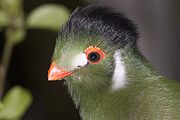
Softbill
Encyclopedia

The term softbill is not a scientific one and has been used, and more often misused, in aviculture
Aviculture
Aviculture is the practice of keeping and breeding birds and the culture that forms around it. Aviculture is generally focused on not only the raising and breeding of birds, but also on preserving avian habitat, and public awareness campaigns....
for numerous years. It is a very misleading title, as many species that fall into the category do not have a soft bill at all; anyone who has ever been attacked by a hornbill
Hornbill
Hornbills are a family of bird found in tropical and subtropical Africa, Asia and Melanesia. They are characterized by a long, down-curved bill which is frequently brightly-colored and sometimes has a casque on the upper mandible. Both the common English and the scientific name of the family...
can attest to this.
The proper use of the term is in reference to the ‘soft food’ diets which basically fall into the following six categories:
- Carnivorous – those who feed on small mammals, birds or other vertebrates (e.g., Kingfishers, Rollers)
- Insectivorous – those who feed on insects and other invertebrates (e.g., Bee-eaters, Fly-catchers)
- Omnivorous – those who feed on both animal and plant material (e.g., Corvids, Hornbills)
- Frugivorous – those who feed on fruit (e.g., Turacos, Fruit Doves)
- Nectarivorous – those who feed on flower nectar (e.g., Hummingbirds, Sunbirds)
- Folivorous – those who feed on leafs, petals and other plant material (Turacos, Mousebirds)
This sixth diet type is usually in association with one of the above, as very few birds are solely foliverous, a few species of Galliforme come to mind, however they are not considered to be Softbills.
A more recent definition by Clive Roots is, “Cage and aviary birds with relatively soft bills, which feed upon insects* and soft plant material and whose young are helpless at birth”.
- including other larger animal prey
This latter definition does discriminate against a few species, however as can be seen, the definition is very subjective and can encompass numerous species not generally included in the group.

